By Lawrence Haywood, Mar 1, 2025
There’s a curious contradiction of life that occurs every day, just over an hour’s drive southwest of central Ho Chi Minh City. The stretching coconut trees and ambitious ferns that line the languid waters of the Mekong Delta suggest that life here might be a rather reclined affair.
To saunter up and down the river absorbing the seemingly endless verdant greenery is to experience the Mekong Delta as its most beautiful. However, another hour southwest and you’ll find yourself in a whirlwind of activity, one that sweeps up visitors into the agitation of a floating market and pushes all thoughts of serene backwaters to the back of their memory. Accompany us to find out in this Vietnam travel tips & experiences to the Mekong Delta!
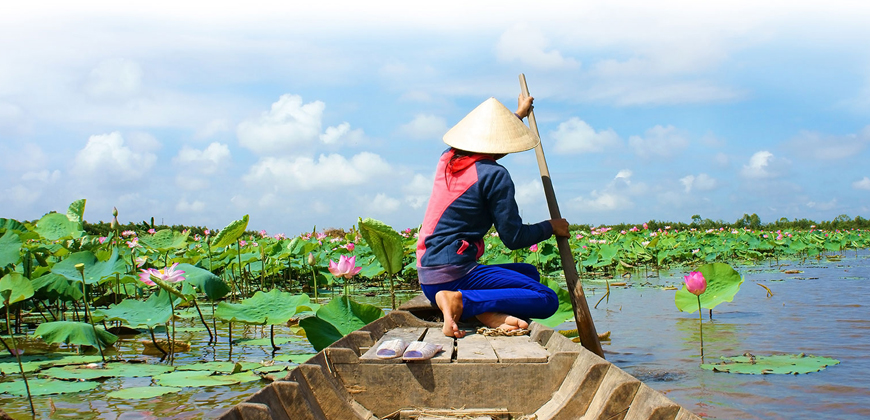
A woman rowing the rowboat to pick lotus flower
Indeed, the pace of life in the Mekong Delta can go from a mild stroll to Formula 1 within the space of an hour, and its potential to do so speaks of a deep-rooted history in the very diverse region. This 15,000 square mile expanse makes up the very end of the tail of Vietnam’s rising dragon, a land body stretching from the fertile Mekong Delta to the dragon’s head in the northern provinces of the country. Around 2300 years of habitation has given rise to multiple cultures, various languages, different food, drink, transport and attitudes to life around the 12 provinces that comprise the region in modern Vietnam.
So, unsurprisingly, there are many things to do in Vietnam’s Mekong Delta, and any exploration of the south should focus at least one day in both the placid canals and the effervescent floating markets. At Incredible Asia Journeys, we’ve created this comprehensive guide to the top attractions in Vietnam’s Mekong Delta.
Thousands of boats once made up the floating market at Cai Rang, but modern Vietnam has less time for genuine business on the river now that bridges carry large-haul trucks straight over it. Still, the sight of hundreds of shop-boats plying the silken waterways is one of Vietnam’s typical scenes and visiting the bubbling floating markets is most certainly one of the top things to do in the Mekong Delta.
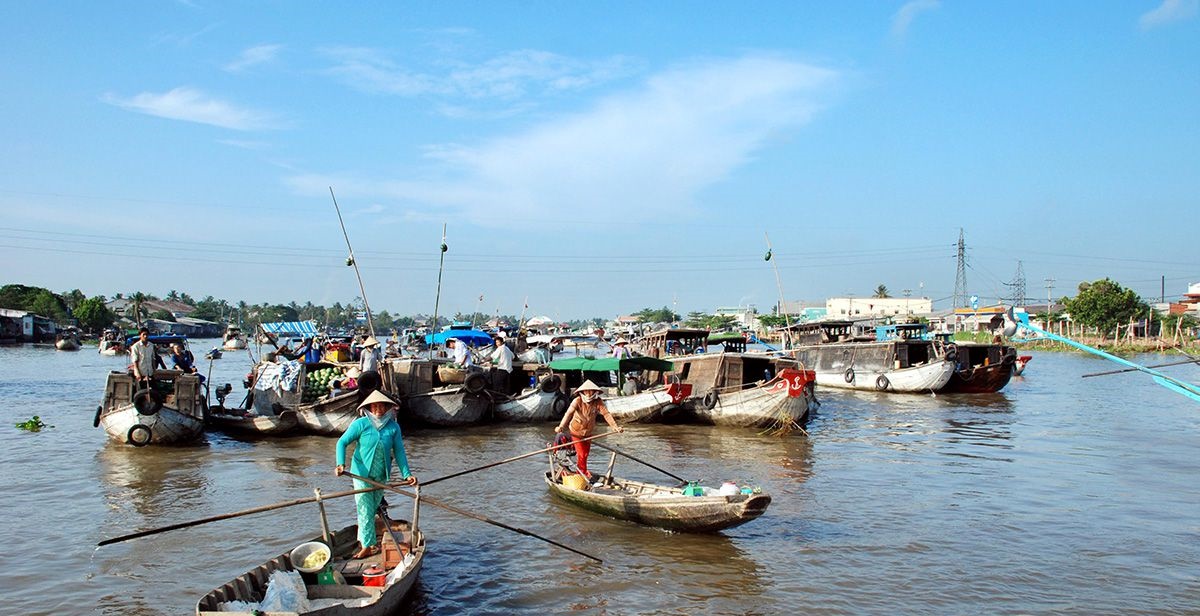
Cai Rang Floating Market was recognized as a National Intangible Cultural Heritage in 2016
The most lively, colourful market in the Mekong Delta is, naturally, its most famous. The 300-or-so boats that remain on the waters of the Mekong at Cai Rang continue life unabated; selling produce, cooking food and generally revelling in the vivacity around it. From a sampan boat, a local of Can Tho City, 6km from the market, will row you out, taking you on an unplanned route around the mass of boats, flitting in between gaps and generally greeting all 300 of their friends in endearingly boisterous ways.
Vendors at Cai Rang have to hang their wares from the top of a pole that rises above all the water-level bustle. You can see the flags of fruit, clothes and upturned, empty liquor bottles standing high above the boat, adding to the intensely colourful scene from above. Vendors selling food tend to rely on people’s sense of smell rather than nailing a lone noodle to the top of a pole, and far-off boats can be beckoned closer with the help of your very obliging boat rower.
If the idea of two hours on a sampan boat amid a maelstrom of activity doesn’t appeal to you, feel free to head to Vinh Long Province, 2 hours from Ho Chi Minh City. There are a few advantages to heading to Cai Be over Cai Rang, including the much shorter travel time, fewer tourists, less hustling and the fact that Cai Be stays open later for visitors arriving from Ho Chi Minh City. Cai Be sells pretty much the same merchandise as Cai Rang, with the only difference in scenery being a picturesque Catholic cathedral that stands on the riverbanks.
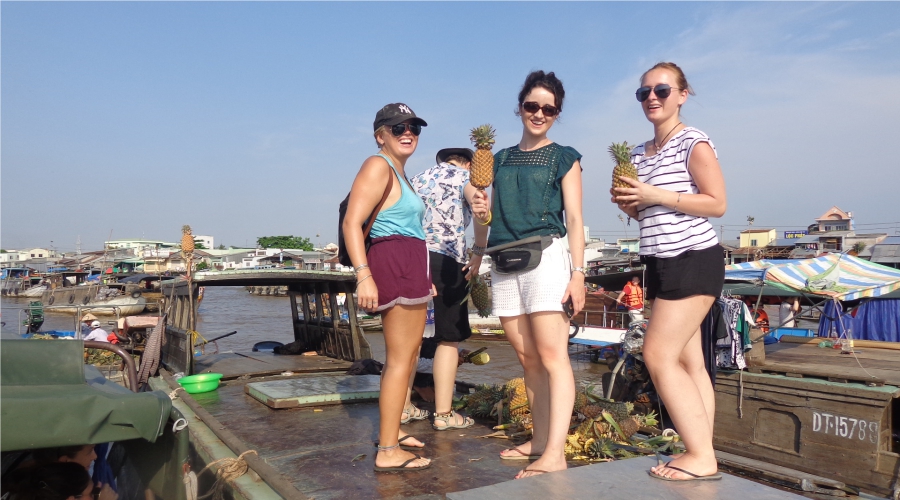
Tourists are excited to visit the Cai Be floating market
A lot of the Mekong Delta’s floating markets are very similar, and a visit to more than one is unnecessary, but if you’re more into local experiences, then Long Xuyen in An Giang Province is the one you should visit. Long Xuyen doesn’t usually make any ‘top things to do in Mekong Delta’ lists, but its exclusion is perfect for travellers looking for hidden gems and a lack of commercialisation. There is still a lively atmosphere but the pressure for buying which is sometimes felt at Cai Rang and Cai Be is much milder here, giving you free reign over a bountiful market operated and visited almost exclusively by locals.
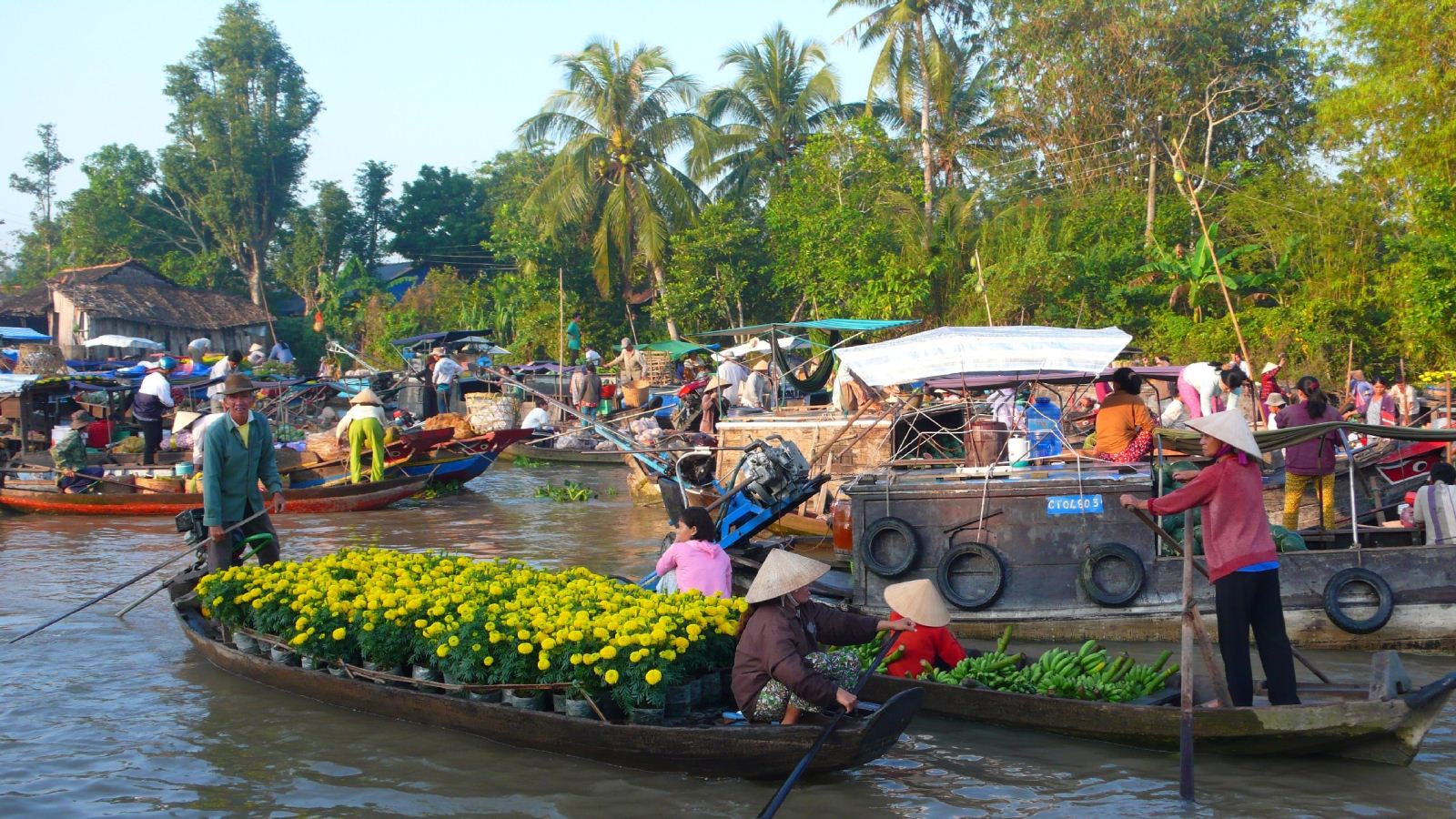
Long Xuyen floating market is called by many people as a floating village in An Giang
While many people argue between the food cultures of Hanoi and Ho Chi Minh City, it should be noted that the deep south of Vietnam has its own traditions and dishes that they are rightly proud of. Steaming bowls of Hu Tieu and Leo are doled out daily from rustic boats across the Mekong Delta’s floating markets, giving tourists a chance to taste a unique, seafood and fruit-based culture that evolved over thousands of years. The region’s tropical fruits account for a staggering 70% of the entire country, and, in a country as obsessed with rice as Vietnam, to have 60% of its overall output of this precious grain must feel like an incredible achievement. Indulge yourself in the food here, it’s certainly one of the best activities in Vietnam’s Mekong Delta.
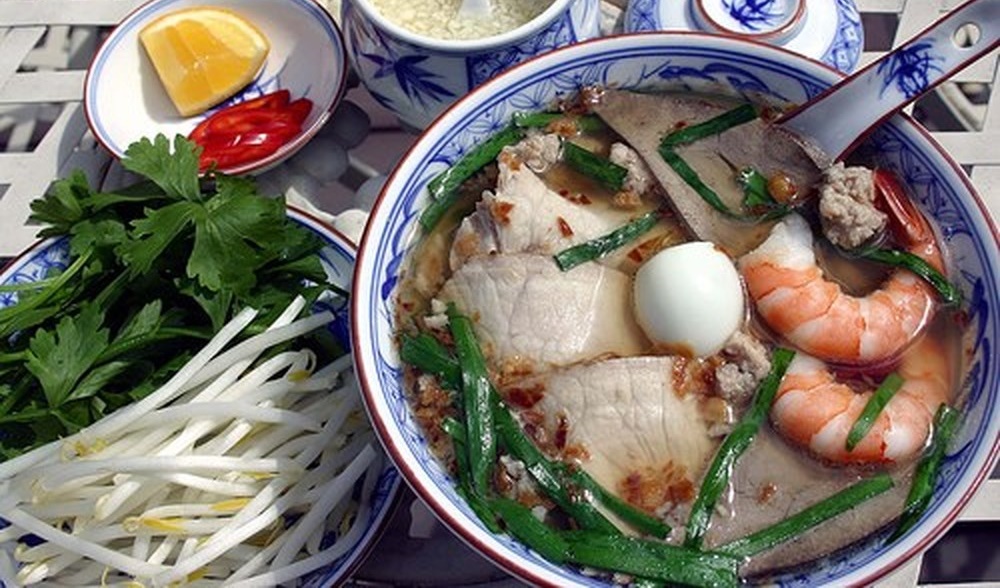
A bowl of Hu Tieu
As with the rest of the country, the colourful appearance of the food in the Mekong Delta makes up for half of its appeal. Brown fish balls, pink and purple squid, red pepper, green celery, light orange shrimp and white noodles get to know each other in a clear broth of Hu Tieu, one of the deep south’s most beloved specialities. The presence of seafood is felt strongly in Hu Tieu, and you can enjoy its salty flavour while floating serenely on the Mekong. Gordon Ramsay did exactly this and was compelled to deem the broth of Hu Tieu the best he’s ever had.
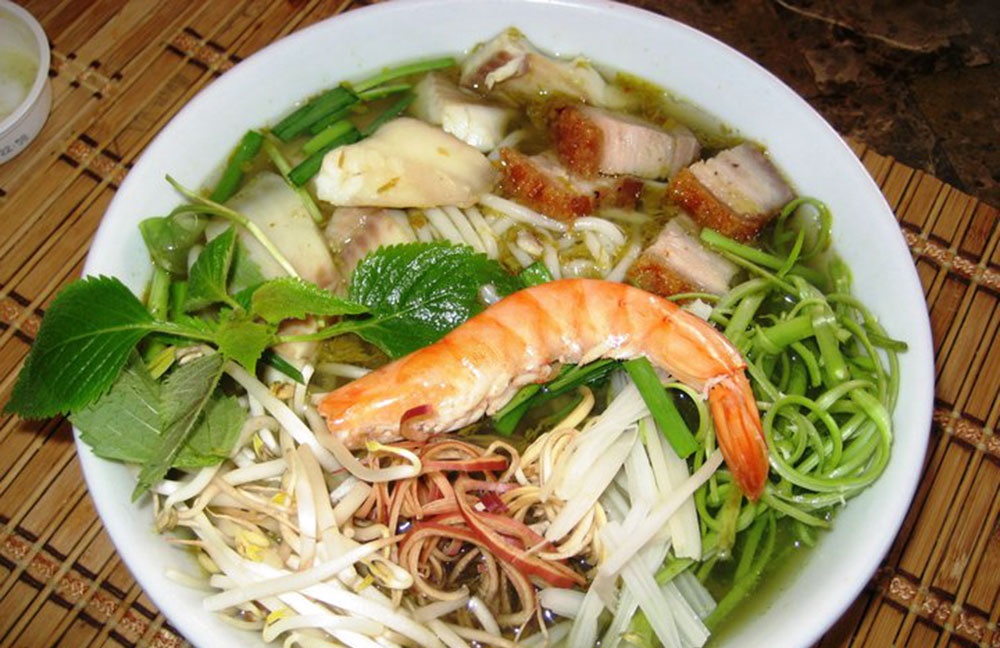
Bun Nuoc Leo
Presented as a small bowl overflowing with vibrant ingredients, Bun Nuoc Leo is one of many Vietnamese dishes that was carried out of the south after the fall of Saigon, finding favour throughout the world where Vietnamese refugees settled. Its origins are actually from the Khmer people of Cambodia, but it was adapted by the chefs of Soc Trang, one of the Mekong Delta’s more southern provinces and now contains a lot of fish stock and pickled fish, along with shrimp and fish balls. It’s a fishy dish, for sure.

Banh Cong
Banh Cong is a simple concoction of two things that don’t really sound like they should go together, but it’s fortunate that someone thought to try it; shrimp and cake. These are small ‘shrimp muffins’ containing shrimp, ground pork, onion and shallots baked into a light, fluffy cake. Banh Cong is incredibly moreish and sharing a few with the locals of Soc Trang Province, where they originate, is one of the top highlights of a local experience in the Mekong Delta.
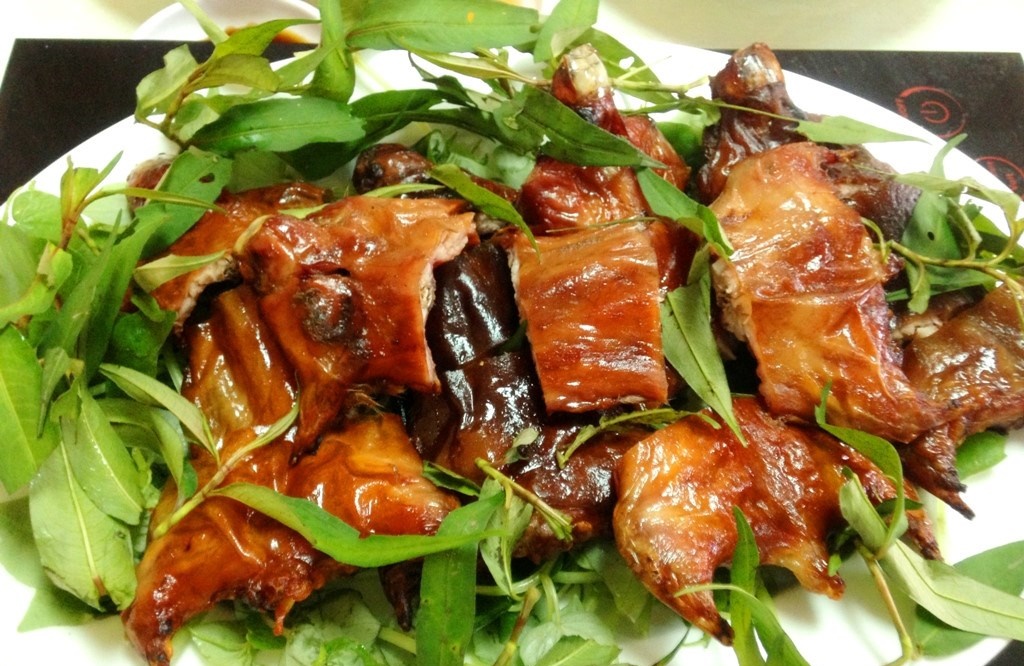
Mouse Meat
Definitely one for the more adventurous tourists to the Mekong Delta, mouse meat is a bit of a delicacy here and available to try if your stomach can take it. Locals have developed methods for cooking mice to mask the flavour of, well, mouse, over several centuries of trying to eradicate the pest from their coconut trees. Mouse meat really kicked off when locals needed all the food they could get during the French and American wars, justifying their cooking by claiming that the coconuts eaten by the mice must have imbued their flesh with the same flavour.
Best tours to Mekong Delta: Mekong Delta Day Trip, Hanoi to Ho Chi Minh Discovery, Foody Tour in Ho Chi Minh and Mekong Delta.
If you are wondering "What to do in Mekong Delta?" Bird watching in the Mekong Delta is a must. The vast swathes of large birds that soar high above the boats are one of the Vietnamese Mekong Delta’s big attractions for bird lovers, who come on bird-watching trips from around the world to witness the majesty of storks, herons, cranes and pelicans as they roost in the trees.
Undoubtedly the best place to see over 300 species of birds, some of which are incredibly rare, is Tram Chim National Park near the border with Cambodia. The huge variety of birds here find their food within the park and its surrounding rivers, swooping with gigantic wings to scoop up fish and take them back to their nests. There are also a great variety of ducks and grebes paddling around the ponds and lakes, while colourful kingfishers, starlings and bee-eaters flit between them in search of food.
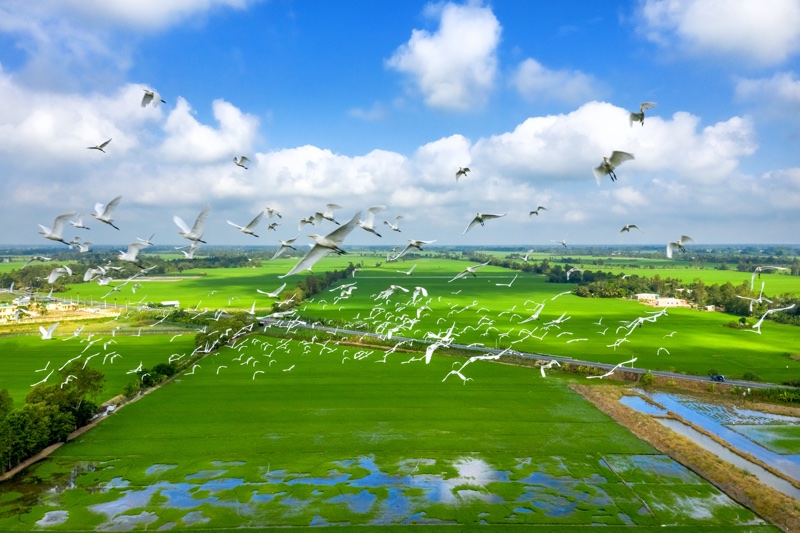
Tram Chim National Park
The vibrating white flecks on the tops of trees at Vam Ho Bird Sanctuary might look like curiously energetic snow from far away, but get closer and you’ll see one of the Mekong Delta’s iconic sights. Thousands of storks return to Vam Ho around sunset every day to roost, which usually sends cameras in sight of the birds into a frenzy of frantic clicks. The protected area is accessible by boat and visitors will be treated to the sights of other large birds like herons and buzzards along with other animals like bats and pythons.

Vam Ho Bird Sanctuary
For getting up close to roosting birds, your best bet is to head to Bang Lang. This sanctuary is sometimes referred to as a ‘stork garden’ because a viewing platform that sits in the canopy gives a wonderful view of the brilliantly white storks as they relax in the trees stretching out in front of you. Aside from every type of stork in the Mekong, you can see egrets, herons, cormorants and many more.
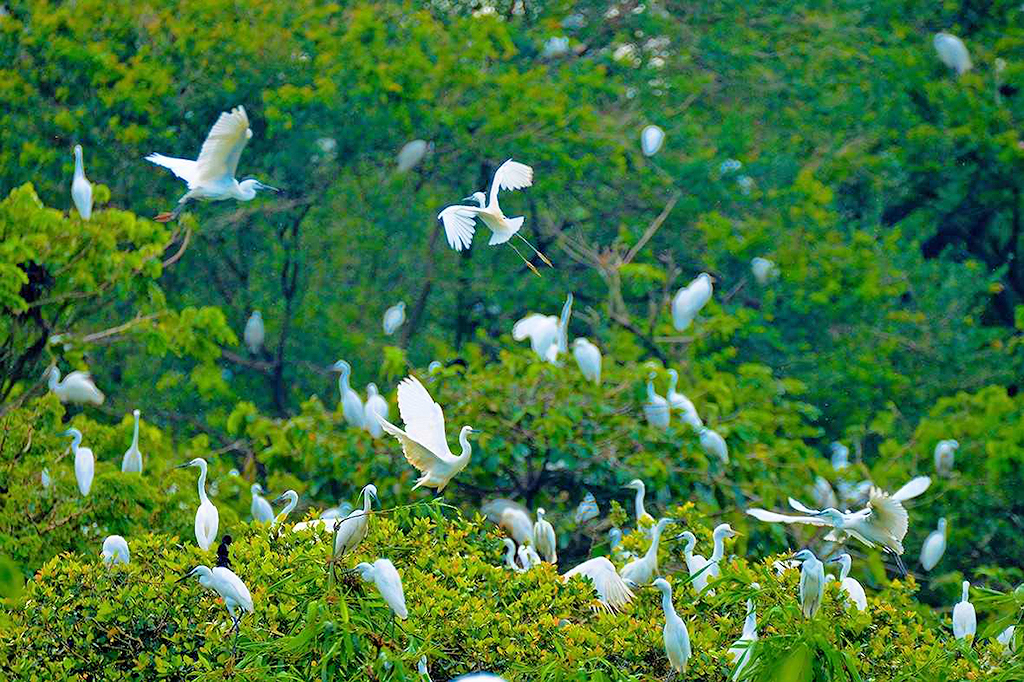
Bang Lang Bird Sanctuary
In a region as naturally blessed as the Mekong Delta, it’s unsurprising that getting into nature is one of the top things to do in the deep South. Aside from Tram Chim National Park mentioned above, there are plenty of places to get up close to the luxuriant greenery birthed by the fertility of the Mekong River.
Indeed, if it’s greenery you’re after, you can’t get more green than a visit to Tra Su Forest, an enchanting collection of canals adorned with water lettuce, so much so that birds can sometimes be seen walking on top of the carpet of green to cross the river. A 15,000 VND ($0.70) trip on a sampan boat will be one of the most relaxing (and cheapest) things you do in the Mekong Delta, drifting through a living mosaic that gently parts as you cut through, looking out for majestic birds, watching the tall cajuput trees sway gently and listening to a soundtrack that nears reflective perfection.
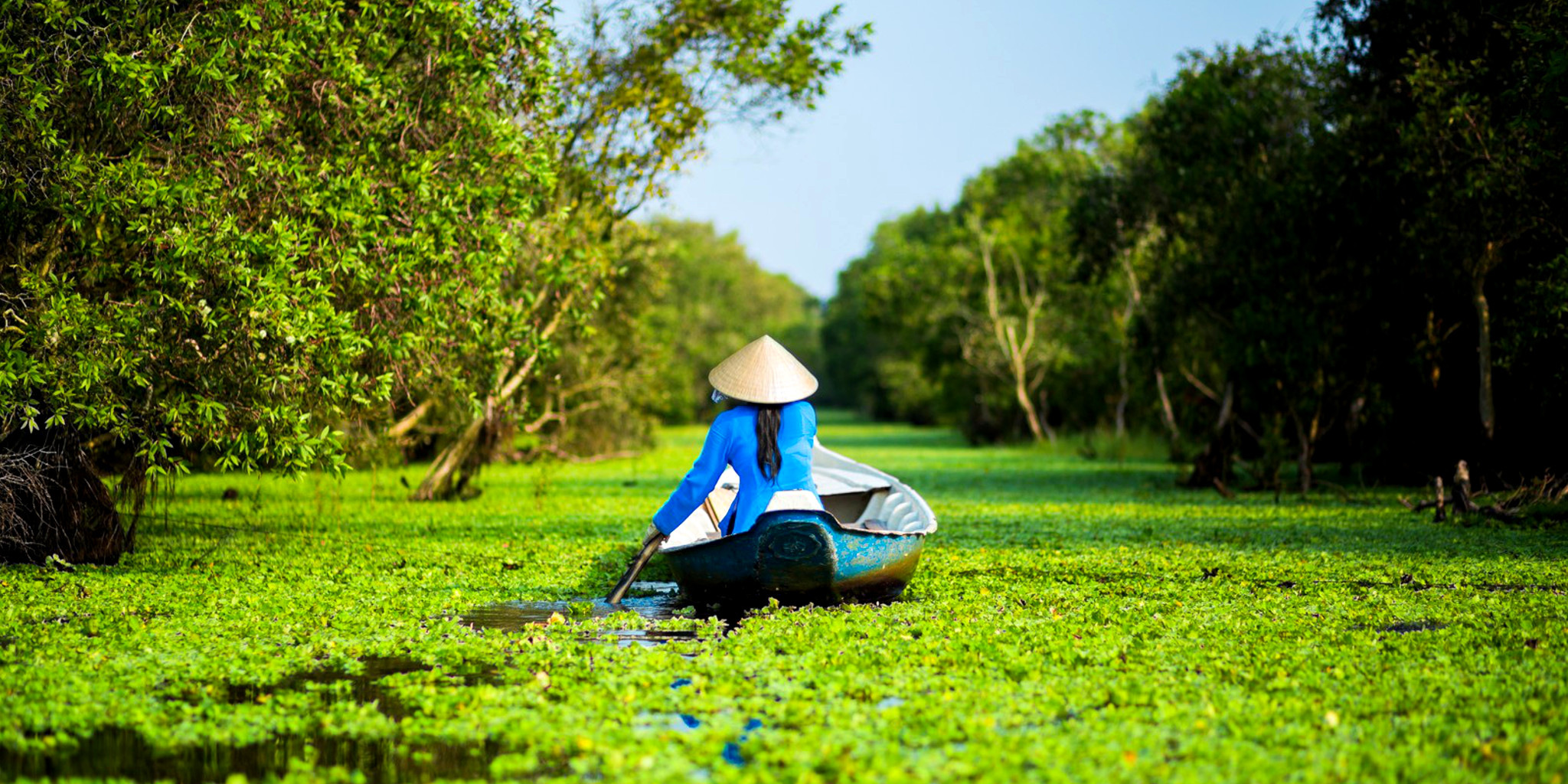
Tra Su Forest
A mixed site of nature and war, U-Minh’s mangrove forest is the largest one of its kind outside of the Amazon. It was a hiding spot for the Viet Cong during the American War and thus withstood a chemical bombardment in a bid to kill the foliage and reveal the soldiers. U-Minh is slowly returning to its natural state thanks to the expulsion of dioxin in its river system caused by years of heavy rain. The park’s wide canal that cuts through Ken Giang Province provides a different boat experience to that of Tra Su Forest, and the presence of fishing cats and otters inside sets it further apart.
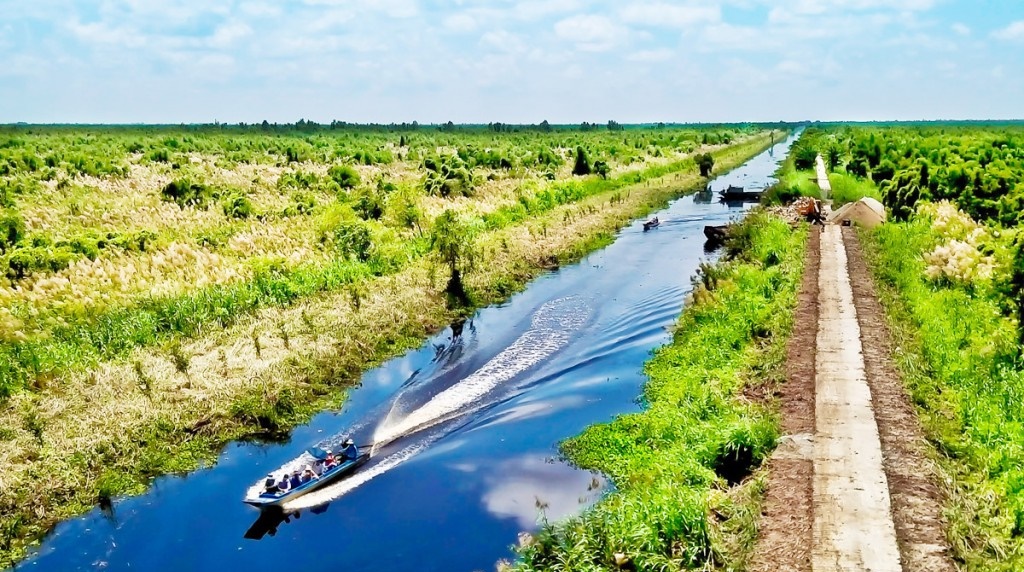
U-Minh Thuong National Park
Aside from the Cai Rang Floating Market, Ben Tre is probably the most popular attraction in the Vietnam Mekong Delta Map. Day tours to Ben Tre from Ho Chi Minh City are the most popular way of visiting this relaxed backwaters, where sampan boats cruise shaded canals below overhanging ferns and palm trees, creating an idyllic ambience and one that should not be missed on a tour of the Mekong Delta. Ben Tre is famous for its coconuts, and all manners of coconut-based food, drink and handicrafts can be tried here for the curious tourist.
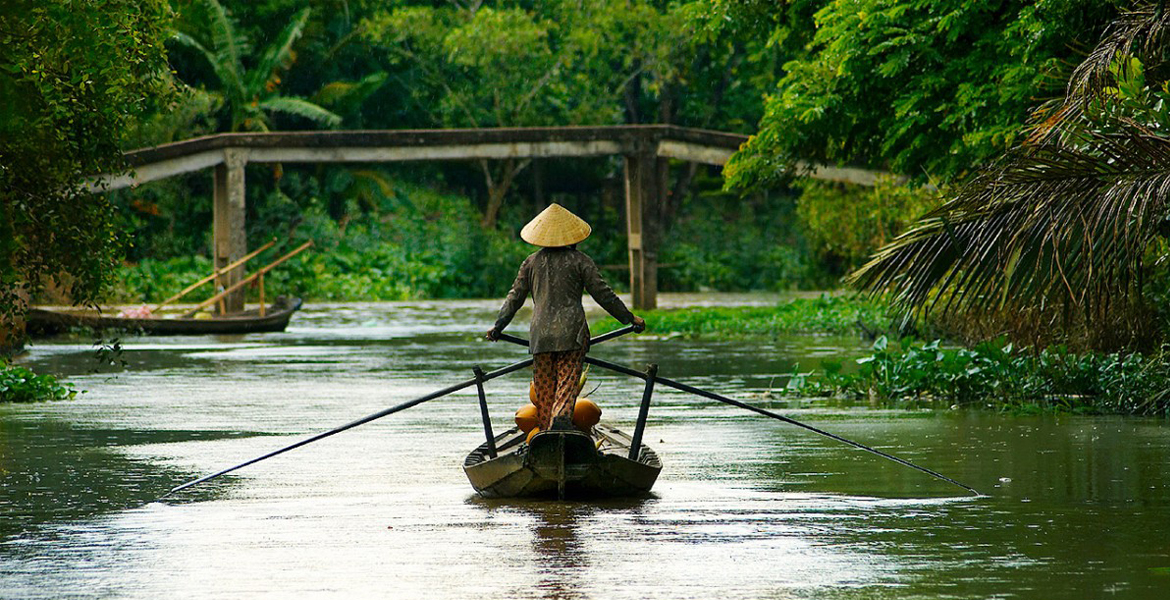
Boating in Ben Tre
Religion took off nicely with the early Vietnamese settlers in the Mekong Delta. Their languid pace of life afforded them plenty of time to build some of the country’s most impressive Buddhist temples. The introduction of Christianity via the French, Spanish and Portuguese missionaries arrived particularly strongly in the Mekong Delta due to its proximity to the sea, where missionaries entered the country.
It’s a combination of the size, vibrant colours, grandiose architecture and intricate detailing that most tourists remark on when visiting Vinh Trang Temple, just outside of My Tho City. The temple has the feel of a European palace with its straight, golden beams; a direct influence from the French, who were well-integrated into the country by 1849 when Vinh Trang was built. Outside influences can be seen in the Korean characters dotted around, as well as the Japanese tiling and bonsai garden, painted Renaissance-style patterns and grand Romanesque arches and pillars. A gigantic bell and two 20-metre-tall Buddha statues make Vinh Trang truly one of the most impressive things to see in the Mekong Delta.
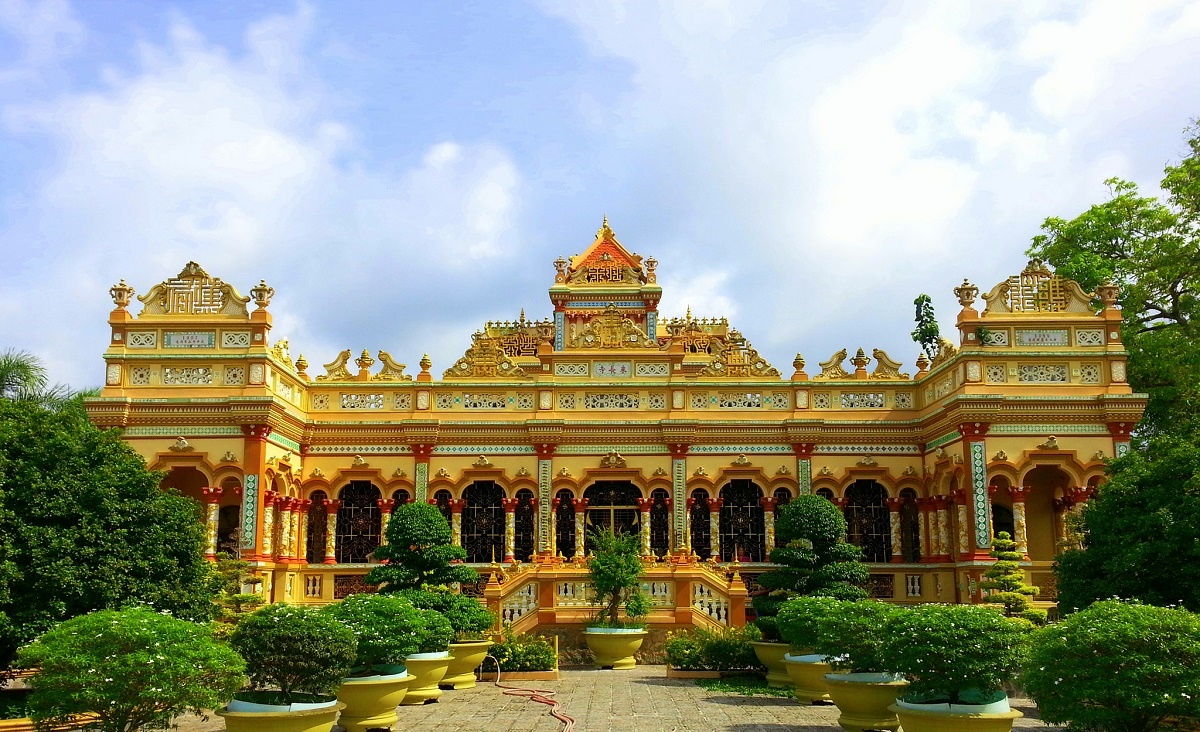
Vinh Trang Temple
The views of flat rice fields lie below visitors to Sam Mountain; a bonus on a pilgrimage to the many temples and shrines that are spattered around this 230-metre tall holy mountain, next to the town of Chau Doc on the Cambodian border. On the way up the mountain, pilgrims stop at Tay An Pagoda, a wonderfully ornate religious building with obvious Indian influences, the Ba Chua Xu Pagoda with obvious Chinese influences, and the Tomb of Thoai Ngoc Hau, which is 100% Vietnamese.

Sam Mountain
The steeply slanted roofs, elaborate patterns and painted gold of Khmer temples can be found mostly in Cambodia. However, the large Khmer population in the Vietnamese Mekong Delta accounts for the four Khmer Temples in Tra Vinh Province, each of which provides a different flavour to the Mekong. Ang Temple survives from the 10th century, while the impressive architecture of Hang Temple includes a gargantuan temple gate. Vam Ray is the oldest Khmer temple in the country and finally, Co Temple (meaning Stork Temple), houses hundreds of large storks presumably in search of enlightenment.
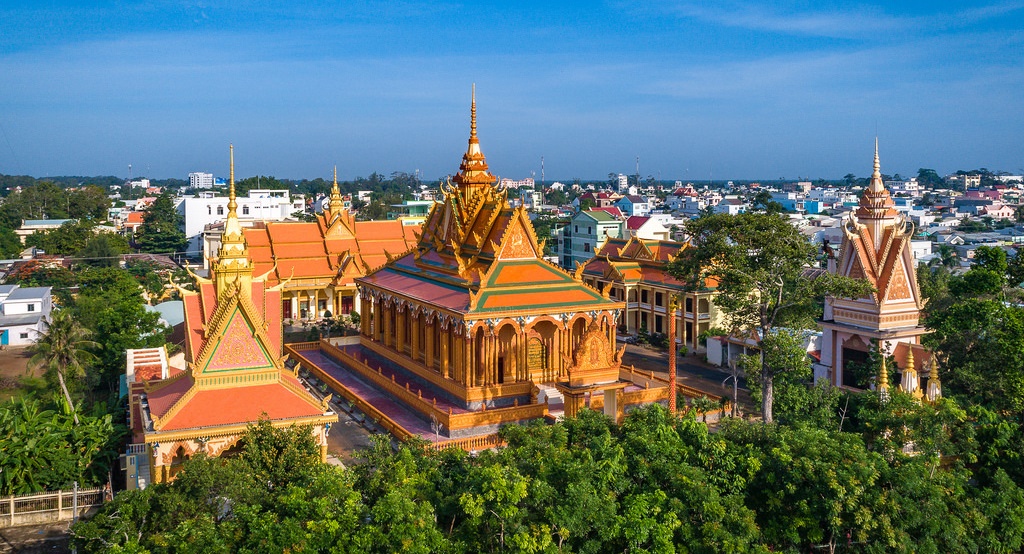 The Khmer Temples of Tra Vinh
The Khmer Temples of Tra Vinh
Book your Vietnam tours at Incredible Asia Journeys to get the best deals and exclusive discounts!